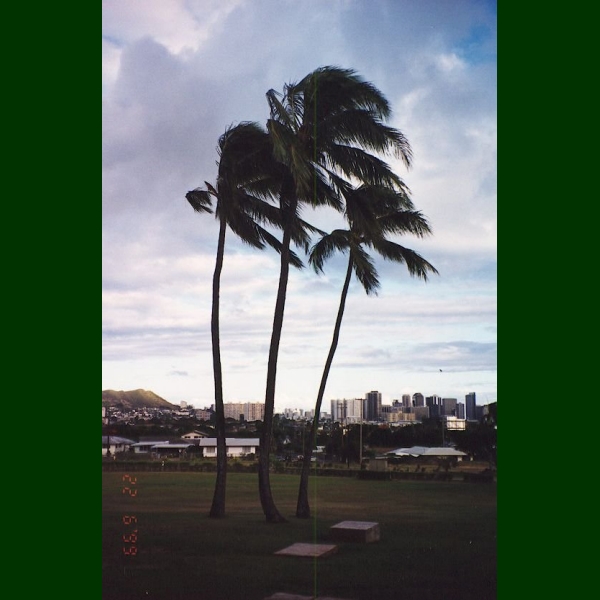 Hawaiian Name(s): niu, ololani
Hawaiian Name(s): niu, ololaniScientific Name: Cocos nucifera
Vernacular Name: coconut
Family: Arecaceae
Status: Polynesian introduction
Authority: L.
Description: Trunk up to 30 m tall, leaves up to 6 m long.
Habitat Widely cultivated and occasionally naturalized, especially along sandy coasts (Wagner et al. 1990:1362–1363).
Medicines: Niu flesh, oil, leaf buds, and water were used in numerous medicines (see other plants). These include formulations for lepo pa‘a (constipation), ‘ea (thrush), pa‘ao‘ao, and the "illness related to lolo"; in addition, the leaf bud is made into a topical medicine for ‘eha moku kukonukonu and ‘eha ‘ulia wale (Chun 1998:41).
Non Medicinal Uses: Niu (coconut) has many uses. The trunks used to make house posts, small canoes, hula drums, or food containers (Handy et al. 1972:173–175). Leaves (launiu) used to for baskets, thatch and for fans, known as some of the finest in Polynesia (Abbott 1993:61, 76; Summers 1990:75–78). Leaf sheaths used as food or fish-bait wrappers (Handy et al. 1972:173). Husk fibers also used for cordage to make nets or lashing, known as 'aha (Summers 1990:75); the cordage could be coarse or fine. The cordage can be made into supports for ‘umeke (bowls) or other round-based objects. Shell of fruit was used for eating utensils, such as spoons, bowls, plates, as well as ‘awa cups and strainers for ‘awa. An historic period piece in the Bishop Museum ethnology collection is in the form of a goblet. Niu shells also served for storage containers, lids, and knee drums or puniu (Krauss 1993:80–87; Handy et al. 1972:173–175); the fibers are made into a drum beater. A musical instrument, the hokiokio, can also be made from coconut shell. Small mortars and bull roarers (oeoe) are also made from the niu shell (Krauss 1993:45, 98–99). Niu water used as a drink, and flesh eaten raw or with poi (Handy et al. 1972:171. Some of the most familiar preparations of niu were not developed by ancient Hawaiians. Sometimes the niu "shell" used to make ‘uli‘uli (hula rattles) (Handy et al.1972:174). Oil from meat used on body and hair (Handy et al. 1972:174). In the Bishop Museum ethnology collection there are examples of the husk fibers used as kapa and a brush, and the leaves and husk as part of a game. The wood could be fashioned into an ‘ukeke, or musical bow. The mid-rib of the niu leaf is used as the "skewer" for a kukui nut torch (kali lukui) (Abbott 1992:77). Some recognize two forms introduced by Polynesians: niu hiwa (dark green husk and black shell) used ceremonially, medicinally and for cooking; niu lelo (reddish yellow husk and yellow shell), used for secular purposes, not for medicine or ceremonies (Handy et al. 1972:170; Summers 1990:75–78). In the Bishop Museum Ethnology collection there is an example of a post-contact bowl made from the trunk of the niu.
Specific gravity of wood: unknown
Famous Locations:
Mele: "I ka wai…o ka niu…haohao," line in "Niu Haohao" "I ka ‘olu o ka niu" line in "Old Plantation" "‘O ka holunape a ka lau o ka niu la" line in "Royal Hawaiian Hotel" (Elbert & Mahoe 1970).
`Ōlelo Noeau:
Dye Color and Parts:
Kino lau: KU. NIUOLAHIKI.
Location on Bishop Museum Kalihi Campus: on the Great Lawn
Propagation Information: Place dried nut with liquid remaining in a ditch of well drained soil with partial shade, water daily; when leaf shoot appears dig nut out carefully & plant horizontally 1/2 inch soil in desired location keeping trees 15-20 feet apart (Burgess and Enos 1996:26; Handy et al. 1972:172).
Native Plants Hawaii.
